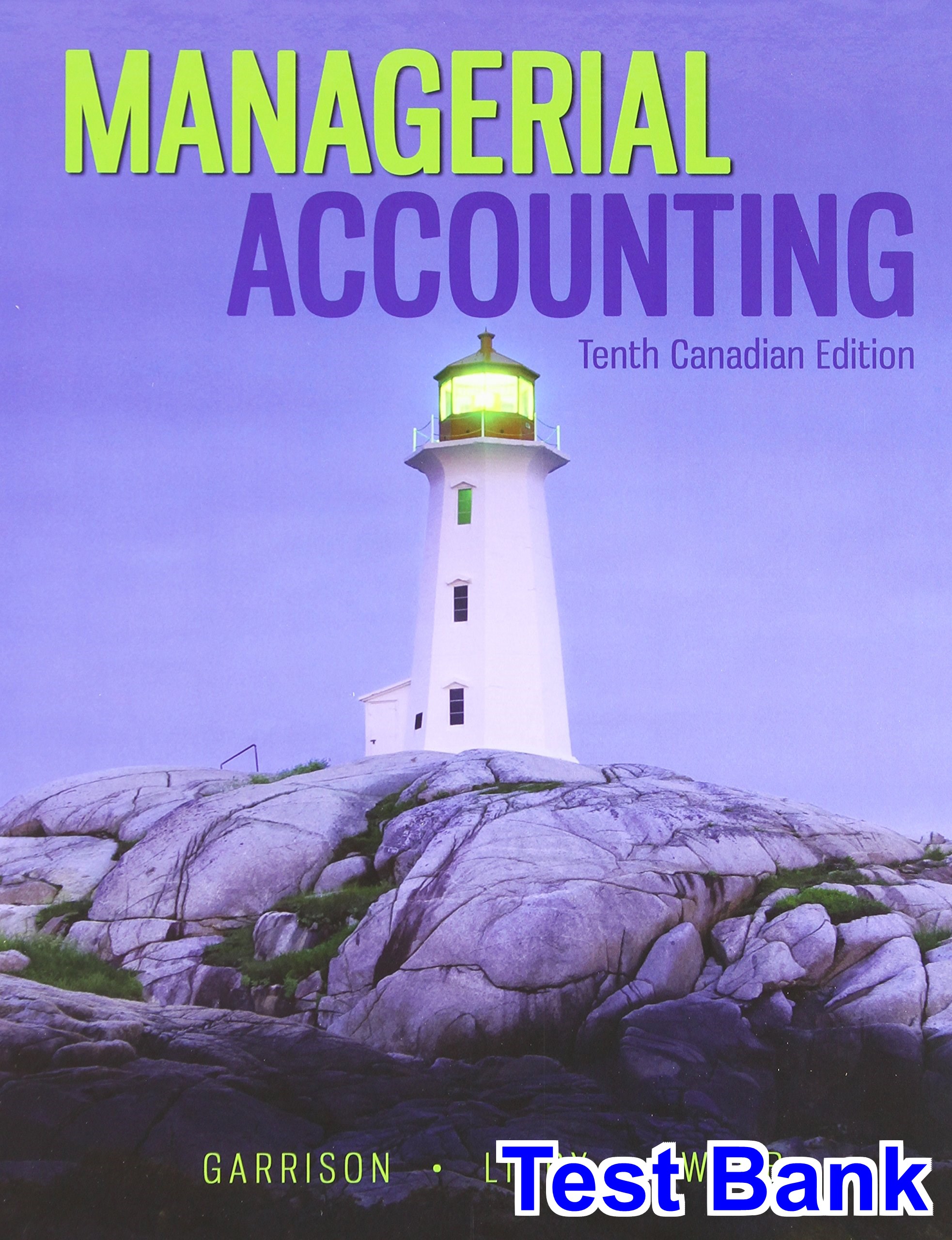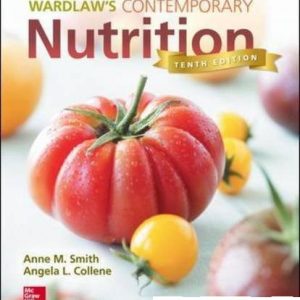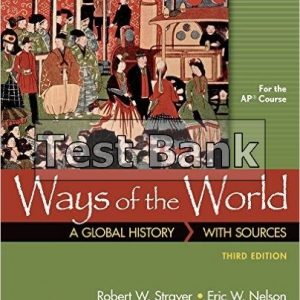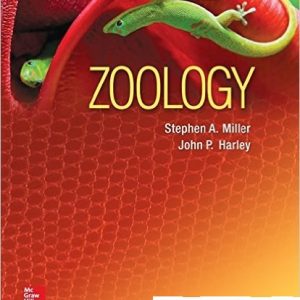This is completed downloadable of Managerial Accounting Canadian Canadian 10th Edition Garrison Test Bank

Product Details:
- ISBN-10 : 1259024903
- ISBN-13 : 978-1259024900
- Author: Garrison
Family owned and operated since 1961. Located in Downtown Victoria selling new, used, and remainder titles in all categories. We also have an extensive selection of Journals, cards and calendars.
Table of Content:
Chapter 6 Systems Design: Process Costing
Solution to Discussion Case Estimating percentage of completion of products requires a judgment call. As with all areas where judgment comes to play, managers will tend to be more or less conservative depending on several factors including the degree to which they inherently tend toward conservative estimates and forecasts. From the perspective of the organization, the objective is to provide as accurate an estimate of percentage of completion as possible in order to better understand and control costs and to ensure the integrity of the costing system. Even so, managers also have incentives to improve profit, both for the shareholder’s sake as well as to meet performance evaluation and bonus targets each year. But “misestimating” is likely of only short term benefit since the Board will quite quickly fail to trust the manager’s esti-
Solutions Manual, Chapter 6
1
mated percentage of completion if they prove to be wrong over several periods. Once this happens, the company would be foolish to continue to provide incentives to base bonuses on divisional profit figures if these figures cannot be trusted. In the end, the benefit of subverting the integrity of the accounting system is likely much lower than the potential long-term reputational cost.
© McGraw-Hill Ryerson Ltd., 2015. All rights reserved. 2
Managerial Accounting, 10th Edition
Solutions to Questions 6-1 A process costing system should be used in situations where a homogeneous products or services are produced on a continuous basis. 6-2 1. In job-order costing many different jobs are worked on during each period each with its own production requirements. In process costing, a single product is produced on a continuous basis and all units are identical. 2. The job cost sheet is the key document in job-order costing while the department production report is the key document in process costing. 3. Unit costs are computed by job in job-order costing while unit costs are computed by department in process costing. 6-3 Cost accumulation is simpler under process costing because costs only need to be assigned to departments—not separate jobs. A company usually has a small number of processing departments, whereas a job-order costing system often must keep track of the costs of hundreds or even thousands of jobs.
6-8 Disagree. In fact, flexible manufacturing systems may actually increase the use of process costing over time. These systems can have a major impact on costing since they allow for an easy switch from producing one type of product to another. The systems’ flexibility means product switching results in little time lost and relatively low setup costs. Therefore, companies are able to move between products with about the same speed as they would if they were working in a continuous processing environment. As the use of flexible manufacturing systems grows, so should the application of process costing techniques. 6-9 Advantages of the weighted average method include: computations are simpler; the managers does not need information at too fine a level of detail so the average is informative enough; there is little change in cost from period to period; ending inventory are typically low each period so the average ends up being quite accurate.
6-4 In a process costing system, a Work in Process account is maintained for each processing department. 6-5 The journal entry would be: Work in Process,- Firing …… XXXX Work in Process-, Mixing … XXXX 6-6 The costs that might be added to the Firing Department’s Work in Process account during the period are, (1) transferred-in costs from the Mixing Department; (2) materials costs; (3) labour costs; and (4) overhead costs added in the Firing Department. 6-7 Under the weighted-average method, equivalent units of production consist of units transferred to the next department (or to finished goods) during the period plus the equivalent units in the department’s ending work in process inventory.
Solutions Manual, Chapter 6
3
Exercise 6-1 (20 minutes) a. To record issuing raw materials for use in production: Work in Process—Moulding Department ……. 28,000 Work in Process—Firing Department…………. 5,000 Raw Materials …………………………………
33,000
b. To record direct labour costs incurred: Work in Process—Moulding Department ……. Work in Process—Firing Department…………. Wages Payable ……………………………….
18,000 5,000
23,000
c. To record applying manufacturing overhead: Work in Process—Moulding Department ……. Work in Process—Firing Department…………. Manufacturing Overhead …………………..
24,000 37,000
61,000
d. To record transfer of unfired, molded bricks from the Molding Department to the Firing Department: Work in Process—Firing Department…………. 67,000 Work in Process—Moulding Department . 67,000 e. To record transfer of finished bricks from the Firing Department to the finished goods warehouse: Finished Goods…………………………………….. 108,000 Work in Process—Firing Department …… 108,000 f. To record Cost of Goods Sold: Cost of Goods Sold ……………………………….. Finished Goods ……………………………….
4
106,000
106,000
Managerial Accounting, 10th Canadian Edition
Exercise 6-2 (10 minutes) Weighted-Average Method
Quantity Schedule
Units to be accounted for: Work in process, October 1 Units started into production Total units
Units transferred to the next department ……………………………………… Ending work in process: Materials: 15,000 units × 70% complete………………………………. Conversion: 15,000 units × 50% complete………………………………. Equivalent units of production ………..
Solutions Manual, Chapter 2
25,000 195,000 220,000
Equivalent Units Materials Conversion 205,000
205,000
15,000
10,500
220,000
215,500
205,000
7,500 212,500
5
Exercise 6-3 (10 minutes) Weighted-Average Method Costs per Equivalent Unit:
Work in process, May 1 … Cost added during May … Total cost (a) …………….. Equivalent units of production (b) …………. Cost per equivalent unit (a) ÷ (b) …………………
Total Cost
Materials Labour Overhead
$156,270 $ 14,550 $23,620 $118,100 174,330 88,350 14,330 71,650 $330,600 $102,900 $37,950 $189,750 ———
1,200
1,100
1,100
$85.75
$34.50
$172.50
Total cost per equivalent Unit = $85.75 + $34.50 + $172.50 = $292.75
6
Managerial Accounting, 10th Canadian Edition
Exercise 6-4 (10 minutes) Weighted-Average Method
Ending work in process inventory:
Equivalent units of production ……………. Cost per equivalent unit ……………………. Cost of ending work in process inventory
Units completed and transferred out:
Units transferred to the next department Cost per equivalent unit ……………………. Cost of units completed and transferred out ……………………………………………
Solutions Manual, Chapter 2
Materials
Conversion
Total
300 $31.56 $9,468
100 $9.32 $932 $10,400
1,300 $31.56
1,300 $9.32
$41,028
$12,116 $53,144
7
Exercise 6-5 (10 minutes) Work in Process—Mixing …………………………… Raw Materials Inventory ……………………….
330,000
Work in Process—Mixing …………………………… Work in Process—Baking …………………………… Wages Payable ……………………………………
260,000 120,000
Work in Process—Mixing …………………………… Work in Process—Baking …………………………… Manufacturing Overhead ……………………….
190,000 90,000
Work in Process—Baking …………………………… Work in Process—Mixing ……………………….
760,000
Finished Goods ……………………………………….. Work in Process—Baking……………………….
980,000
8
330,000
380,000
280,000 760,000 980,000
Managerial Accounting, 10th Canadian Edition
Exercise 6-6 (20 minutes) Weighted-Average Method 1. Equivalent Units (EU) Litres transferred to the next department during June* ……………………………………………………… Work in process, June 30: Materials: 50,000 litres × 60% complete ………… Labour and overhead: 50,000 litres × 20% complete …………………………………………………….. Equivalent units of production …………………………
Labour & Materials Overhead 790,000
790,000
30,000 820,000
10,000 800,000
* Beginning WIP 80,000 + Started 760,000 – Ending WIP 50,000 = 790,000 litres. 2. Cost per Equivalent Unit: Cost of beginning work in process ….. Costs added during June …………….. Total cost (a) …………………………….. Equivalent units of production (b) ….. Cost per equivalent unit (a) ÷ (b) …..
Solutions Manual, Chapter 2
Materials
Labour
Overhead
$ 68,600 $ 30,000 $ 48,000 907,200 370,000 592,000 $975,800 $400,000 $640,000 820,000 800,000 800,000 $1.19 $.50 $.80
9
Exercise 6-7 (10 minutes) Weighted-Average Method Equivalent Units (EU) Litres transferred to the Heating Department during October* …………………………………………….. Work in process, October 31: Materials: 5,000 litres × 100% complete ………… Labour and overhead: 5,000 litres × 70% complete …………………………………………………….. Equivalent units of production …………………………
Labour & Materials Overhead 45,000
45,000
5,000 50,000
3,500 48,500
* Beginning WIP 25,000 + Started 25,000 – Ending WIP 5,000 = 45,000 litres .
10
Managerial Accounting, 10th Canadian Edition
Exercise 6-8 (30 minutes) Weighted-Average Method 1. Equivalent Units: Materials Conversion Units transferred to the next process ………. 320,000 320,000 Ending work in process: Materials: 60,000 units × 45% complete .. 27,000 Conversion: 60,000 units × 20% complete. 12,000 Equivalent units of production ……………….. 347,000 332,000 2. Costs per Equivalent Unit: Materials Conversion Cost of beginning work in process ………….. $ 76,600 $ 34,900 Cost added during the period ………………… 410,000 234,500 Total cost (a) …………………………………….. $486,600 $269,400 Equivalent units of production (b) ………….. 347,000 332,000 Cost per equivalent unit (a) ÷ (b)…………… $1.40 $0.81* 3.
Ending work in process inventory: Equivalent units of production (see above) …………………… Cost per equivalent unit (see above) …………………………. Cost of ending work in process inventory……………………….
Materials Conversion 27,000
12,000
$1.40
$0.81
$37,800
$9,720
Total
$47,520
Units completed and transferred out: Units transferred to the next department …………………… Cost per equivalent unit (see previous exercise) ……. Cost of units completed and transferred out………………….
320,000
320,000
$1.40
$0.81
$448,000
$259,200
$707,200
*rounded
Solutions Manual, Chapter 2
11
12
Managerial Accounting, 10th Canadian Edition
Exercise 6-9 (20 minutes) Cost Reconciliation Cost accounted for as follow: Transferred to Packaging Dept: 45,000 rolls x $14.50 Work in process, January 31: Materials, $10.50 per EU Conversion , $4.00 per EU Total cost accounted for
Solutions Manual, Chapter 2
Total Cost
Materials
$652,500
45,000
$42,000 $12,800 54,800 $707,300
4,000
Conversion
45,000 3,200
13
Problem 6-10 (45 minutes) Weighted-Average Method 1. Equivalent Units of Production Transferred to next department …………………. Ending work in process: Materials: 100,000 units × 60% complete ….. Conversion: 100,000 units × 40% complete .. Equivalent units of production……………………. 2. Cost per Equivalent Unit Cost of beginning work in process …………….. Cost added during the period ………………….. Total cost (a) ……………………………………….. Equivalent units of production (b) …………….. Cost per equivalent unit, (a) ÷ (b) …………….
Materials Conversion 380,000
60,000 440,000
380,000
40,000 420,000
Materials Conversion $ 45,500 425,500 $471,000 440,000 $1.07
$ 25,000 145,000 $170,000 420,000 $0.405*
*rounded 3.
Applying Costs to Units
Materials Ending work in process inventory: Equivalent units of production (materials: 100,000 units × 60% complete; conversion: 100,000 units × 40% complete) ………………………….. 60,000 Cost per equivalent unit ……. $1.07 Cost of ending work in process inventory……………………… $64,200 Units completed and transferred out: Units transferred to the next department ………………….. 380,000 Cost per equivalent unit ……. $1.07
14
Conversion
Total
40,000 $0.405 $16,200
$80,400
380,000 $0.405
Managerial Accounting, 10th Canadian Edition
Cost of units completed and transferred out ………………
Solutions Manual, Chapter 2
$406,600
$153,900 $560,500
15
Problem 6-10 (continued) 4. Cost Reconciliation Costs to be accounted for: Cost of beginning work in process inventory ($45,500 + $25,000) …………………………… Costs added to production during the period ($425,500 + $145,000) ………………………… Total cost to be accounted for …………………. Costs accounted for as follows: Transferred to next department: 380,000 units x $1.475………………………………. Work in process June 30 Materials at $1.07 per EU ……………………….. Conversion at $0.405 per EU …………………… Total cost accounted for ………………………….
$ 70,500 570,500 $641,000 $560,500 64,200 16,200 80,400 $640,900*
*off $100 due to rounding
16
Managerial Accounting, 10th Canadian Edition
Problem 6-11 (45 minutes) Weighted-Average Method 1. Equivalent Units of Production Transferred to next department* ………………… Ending work in process: Materials: 55,000 units × 65% complete ……..
Materials Conversion 395,000
35,750
Conversion: 55,000 units × 30% complete ….. Equivalent units of production……………………..
395,000
16,500 430,750
411,500
*Units transferred to the next department = Units in beginning work in process + Units started into production − Units in ending work in process = 85,000 + 365,000 − 55,000 = 395,000 2. Cost per Equivalent Unit
Materials
Cost of beginning work in process …………….. $ 101,000 Cost added during the period ………………….. 462,000 Total cost (a) ……………………………………….. $563,000 Equivalent units of production (b) …………….. 430,750 Cost per equivalent unit, (a) ÷ (b) …………….
$1.31
Conversion $ 51,000 213,000 $264,000 411,500
$0.64*
*rounded
Solutions Manual, Chapter 2
17
Problem 6-11 (continued) 3. Cost of Ending Work in Process Inventory and Units Transferred Out
Materials Conversion
Ending work in process inventory: Equivalent units of production (materials: 55,000 units × 65% complete; conversion: 55,000 units × 30% complete) …… 35,750 Cost per equivalent unit ……. $1.31 Cost of ending work in process inventory……………………… $46,833 Units completed and transferred out: Units transferred to the next de395,000 partment ……………………… Cost per equivalent unit ……. $1.31 Cost of units completed and transferred out ……………… $517,450
18
Total
16,500 $0.64 $10,560
$57,393
395,000 $0.64 $252,800
$770,250
Managerial Accounting, 10th Canadian Edition
Problem 6-11 (continued) 4. Cost Reconciliation Costs to be accounted for: Cost of beginning work in process inventory ($101,000 + $51,000) ……………………………… Costs added to production during the period ($462,000 + $213,000) …………………………….
$152,000 675,000
Total Cost Costs accounted for as follows: Transferred to the Coating Department 395,000 x $1.95 Work in process, May 31 Materials at $1.31 per EU Conversion at $0.64 per EU Total ending Work in process Total cost
$827,000
$770,250 46,833 10,560 57,393 *$827,643
*Difference of $643 due to rounding of the per unit costs
Solutions Manual, Chapter 2
19
Problem 6-12 (30 minutes) Weighted-Average Method 1. Total units transferred to the next department .. Less units in the May 1 inventory …………………. Units started and completed in May ……………… 2. The equivalent units were:
28,000 8,000 20,000
Materials Conversion
Transferred to next department ……………… Ending work in process: Materials: 6,000 units × 75% complete ….. Conversion: 6,000 units × 50% complete.. Equivalent units of production…………………
28,000
28,000
4,500
3,000 31,000
32,500
3. The costs per equivalent unit were: Cost of beginning work in process …………….. Cost added during the period ………………….. Total cost (a) ……………………………………….. Equivalent units of production (b) …………….. Cost per equivalent unit, (a) ÷ (b) …………….
Materials Conversion £ 9,000 56,000 £65,000 32,500 £2.00
£ 4,400 31,250 £35,650 31,000 £1.15
4. The ending work in process figure is verified as follows:
Materials
Ending work in process inventory: Equivalent units of production (see above) …………………………… Cost per equivalent unit …………….. Cost of ending work in process inventory……………………………….
4,500 £2.00 £9,000
Conversion
Total
3,000 £1.15 £3,450 £12,450
5. Multiplying the total unit cost figure of £3.15 per unit by 1,000 units does not provide a valid estimate of the incremental cost of processing an additional 1,000 units through the department. If there is sufficient idle capacity to process an additional 1,000 units, the incremental cost per unit is almost certainly less than £3.17 per unit because the conversion costs are likely to include fixed costs.
20
Managerial Accounting, 10th Canadian Edition
Problem 6-13 (45 minutes) Weighted-Average Method 1. Equivalent Units of Production
Materials Conversion
Transferred to next department* ………………… 270,000 Ending work in process: Materials: 45,000 kilograms × 100% complete 45,000 2 3 Conversion: 45,000 kilograms × / complete . Equivalent units of production…………………….. 315,000 *35,000 + 280,000 – 45,000 = 270,000. 2. Cost per Equivalent Unit Cost of beginning work in process …………….. Cost added during the period ………………….. Total cost (a) ……………………………………….. Equivalent units of production (b) …………….. Cost per equivalent unit, (a) ÷ (b) …………….
Materials
$ 43,400 397,600 $441,000 315,000 $1.40
270,000
30,000 300,000
Conversion $ 20,300 189,700 $210,000 300,000 $0.70
3. Cost of Ending Work in Process Inventory and Units Transferred Out
Materials Conversion
Ending work in process inventory: Equivalent units of production (see above) ………………….. 45,000 Cost per equivalent unit ……. $1.40 Cost of ending work in process inventory……………………… $63,000 Units completed and transferred out: Units transferred to the next department ……………………… 270,000 Cost per equivalent unit ……. $1.40 Cost of units completed and transferred out ……………… $378,000
Solutions Manual, Chapter 2
Total
30,000 $0.70 $21,000
$84,000
270,000 $0.70
$2.10
$189,000
$567,000
21
Problem 6-13 (continued) 4. In computing unit costs, the weighted-average method mixes costs of the prior period with current period costs. Thus, under the weighted-average method, unit costs are influenced to some extent by what happened in a prior period. This problem becomes particularly significant when attempting to measure performance in the current period. Good (or bad) cost control in the current period might be concealed by the costs that have been brought forward in the beginning inventory. Reference download link: managerial accounting 10th canadian edition solutions pdf managerial accounting garrison 10th edition test bank managerial accounting garrison 10th edition solution manual managerial accounting garrison 10th edition solution manual pdf managerial accounting 10th canadian edition answer key managerial accounting garrison 10th edition solutions pdf managerial accounting hilton 10th edition solutions managerial accounting 10th edition pdf managerial accounting creating value in a dynamic business environment 10th edition solutions
22
People Also Search:
managerial accounting canadian canadian 10th edition garrison
managerial accounting canadian canadian 10th edition garrison download scribd
managerial accounting canadian canadian 10th edition garrison test bank download pdf





